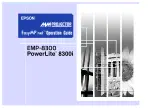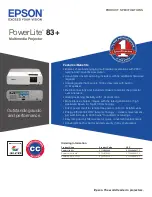
Chapter 1.
1-10
3. Use a DisplayPort cable of this type as shown. Connect one end of the DisplayPort cable
to the DisplayPort connector on the monitor and the other end to a DisplayPort connector
on the computer. To locate the DisplayPort connector on the monitor, see on page 1-4.
4. Use a type B-to-type A USB cable as shown. Connect type B connector of this cable to the
USB 3.0 upstream connector on the monitor. Then, connect type A connector of the cable
to a USB connector on the computer. To locate the USB 3.0 upstream connector on the
monitor, see on page 1-4.
*: Depending on many factors such as the processing capability of peripheral devices, file
attributes, and other factors related to system configuration and operating environments, the
actual transfer rate using the various USB connectors on this device will vary and is typically
slower than the data rates as defined by the respective USB specifications: - 5 Gbit/s for USB
3.1 Gen 1; 10 Gbit/s for USB 3.1 Gen 2 & 20 Gbit/s for USB 3.2.
*
















































